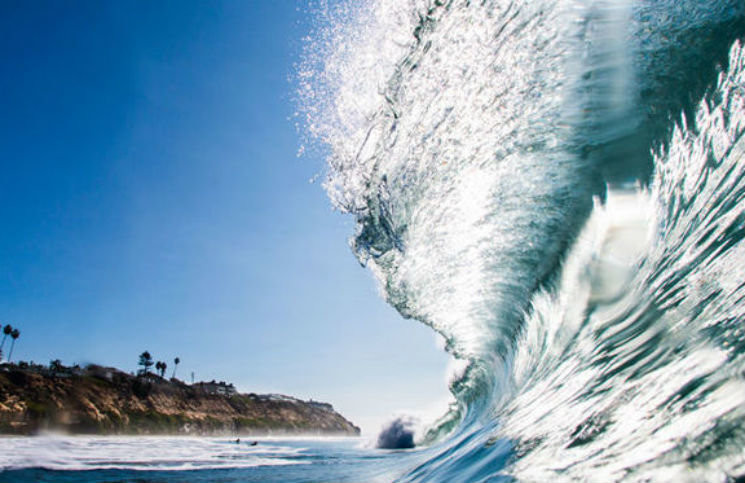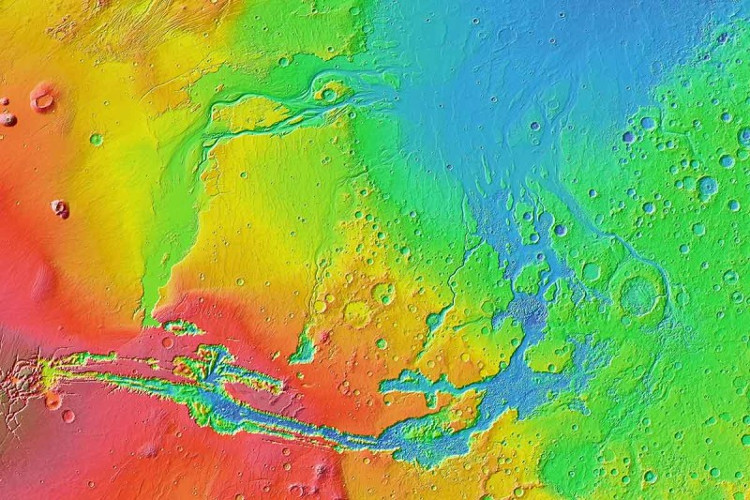Super 50m tsunami can sweep Mars
Tsunami waves 50 meters high can land on the mainland on Mars about 3.4 million years ago after two asteroids collided.
Although Mars today is just a dry, dusty world, much evidence indicates that the red planet once contained a vast ocean. However, the problem still makes scientists wonder if the Martian surface lacks a clear coastline. The boundary between the land and the ocean seems to have a big difference in altitude along the length, according to New Scientist.

A 50m high tsunami used to happen on Mars.(Artwork: Express).
Researcher Alberto Fairén of the Center for Astrobiology in Madrid, Spain, and his colleagues found the answer. They explained that the coastline on Mars was reconstructed by giant tsunamis , leaving ice and stones scattered along a large area. "Tsunami is one of the processes that change the coastline. Our research gives the first official discovery of the ancient tsunami on Mars, " Fairén said.
In a study published yesterday in Scientific Reports, the research team used thermal imaging from the Mars Odyssey spacecraft of the US Aerospace Agency (NASA) to learn the boundary between the Chryse Planitia plains in the land. low and highland area Arabia Terra of Mars. They noticed that the ice and ice lines ran up the slope and spread hundreds of kilometers along the plateau. They cannot be born from processes due to gravity.
According to the research team, two separate tsunamis may have created these currents. The first tsunami reached farther, leaving traces when the water receded to the sea, carrying worn rocks of meters in diameter. The tsunami then occurred at a time when the weather on Mars was colder, not spreading and leaving ice.

Heat the Valles Marineris region on Mars.(Photo: NASA).
Simulations show that a large asteroid is enough to create a 30km-wide crater that triggers a tsunami. The wave is about 50m high when it falls to the shore. Waves entering Indonesia's Sumatra island in the 2004 earthquake were only 30 meters high, killing 185,000 people in the Indian Ocean region and one of the worst natural disasters.
"It's worth noting that when we look more closely at the geology of Mars, we find more and more evidence that it once had an ocean," said Taylor Perron , a researcher at the Massachusetts Institute of Technology. However, the evidence for tsunamis is uncertain, because the traces are greater than all corresponding features on Earth.
"This is a challenging study, because no one knows what the coastline looks like after billions of years and has to wait for confirmation from the Mars research community , " Perron said.
- Colliding with an asteroid, a tsunami of more than 300 meters in height has engulfed Mars
- Evidence of collapsing volcanoes that cause the greatest tsunami in history
- Super volcano on Mars
- Super flood marks stretch over 3,000km on Mars
- Await the astronomical spectacle of a million years
- Super dust storm 'devour' neighbor Earth?
- Big storms destroy the world
- 'Thousands of people' tsunami hit Europe anytime
- Sweep: 2 seconds see the object 2m away
- Mars 'super sharp' image of 'Curious'
- NASA revealed super missiles that brought people to Mars
- Decipher the mysterious tsunami in the East Sea
 Van Allen's belt and evidence that the Apollo 11 mission to the Moon was myth
Van Allen's belt and evidence that the Apollo 11 mission to the Moon was myth The levels of civilization in the universe (Kardashev scale)
The levels of civilization in the universe (Kardashev scale) Today Mars, the sun and the Earth are aligned
Today Mars, the sun and the Earth are aligned The Amazon owner announced a secret plan to build a space base for thousands of people
The Amazon owner announced a secret plan to build a space base for thousands of people